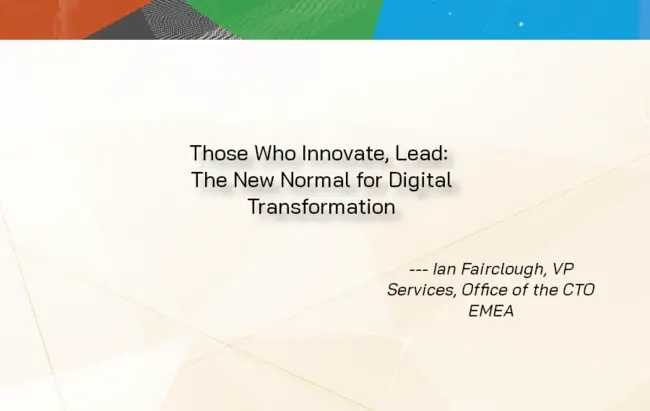Written by Ian Fairclough, VP Services, Office of the CTO EMEA, MuleSoft
The COVID-19 pandemic led to a massive deceleration in the global economy, as organisations and even societies have been forced to wind down their activities in line with lockdown restrictions. The UN estimates that worldwide economic losses from the pandemic will surpass $1 trillion. Yet despite these immediate and painful costs, a notable side-effect of the pandemic is that it seems to have pushed digital initiatives even further up the agenda for many organisations. The ability to launch new digital initiatives quickly has become even more crucial, so many organisations are now reassessing their capability to accelerate digital transformation and innovate faster than ever.

The dramatic increase in digital demand
Much of this pressure is due to changing habits brought about by national lockdowns. Ofcom’s annual Online Nation report recently revealed that the UK’s internet use surged to record levels in April 2020, as adults spent more than a quarter of their waking day online. Increased use of video calling apps, and the move away from traditional television to video streaming platforms caused the demand for digital services to soar. As the demand for these services has risen, so too has the expectation for those services to offer a sophisticated, connected experience. In other words, digital products and services have never been so highly valued.
Even as lockdown restrictions begin to ease, these patterns in consumer behaviour and their rising expectations for digital services look set to remain. This puts many organisations in a tricky situation. Inevitably, budgets have been hit hard by the lockdowns: Gartner estimates that IT spending will fall by 8% in comparison to 2019. With ‘business as usual’ remaining a distant prospect, there’s greater pressure on organisations to find a solution that maximises the value of their existing resources and digital capabilities if they’re to thrive in the ‘new normal’.
Familiar struggles
Even in normal times, IT departments struggled to meet their digital transformation goals as quickly as required. According to research, 59% of IT directors reported that they were unable to deliver all of their projects last year. Much of this is due to IT complexity and the challenges inherent in trying to integrate various data sources, applications and systems in an agile way that supports the goals of transformation. All too often, organisations rely on linking capabilities together with point-to-point integrations, which are inflexible and unsuited to the dynamism of modern IT environments. As a result, they find it hard to quickly launch innovative, customer-centric products and services, as they can’t bring together the capabilities that drive them in a cost and time-effective manner.
At the same time, it’s often the case that digital transformation is left largely to the IT department. IT teams – already stretched by their day-to-day maintenance responsibilities – are increasingly tasked with driving the entire organisation forward, with limited support from other teams in the business. Understandably, this has led to a widening ‘delivery gap’ between what the business expects, and what IT is able to achieve. When we factor in that IT directors will now potentially have fewer resources at their disposal, it’s clear that a solution urgently needs to be found.
APIs and the composable enterprise
To overcome their digital transformation headaches, many organisations have looked to APIs as the solution. With an API strategy in place, IT directors can re-imagine data and capabilities as a series of re-usable ‘building blocks’ that can be plugged in and out to build new products and services quickly. By exposing these APIs via an integration platform, organisations can foster a culture of reuse, so IT teams don’t need to start every digital project from scratch if part of the capability they need has already been created elsewhere. This is what’s known as a composable enterprise strategy, and it makes for a much more agile operation. At a time when organisations need to maximise the value of their resources, those that foster a composable enterprise will be the examples to follow.
One organisation discovering the value of APIs to navigate the pressures of the new normal is the Rail Delivery Group, the UK’s rail industry membership body. Facing a situation where passenger numbers reduced by as much as 95%, the Rail Delivery Group was able to adapt by prioritising digital innovation and equipping itself to quickly launch new customer-facing services to support the key workers still relying on the rail network. By embracing an API strategy, rather than putting the brakes on innovation, the Rail Delivery Group has been able to connect various sources of data, to present customers with a joined-up picture of everything that might affect their journey, such as live updates on the facilities available at stations, or seat availability on trains, to help maintain social distancing. As the rail industry ramps up capacity once more, having the agility to quickly roll out new customer-facing innovations such as these will help manage the transition with greater ease.
The New Normal
It’s fair to assume that ‘normality’ as we knew it won’t return for some time, and the pandemic will leave a permanent mark on businesses and societies alike. Yet the role the pandemic has played in accelerating digital transformation is one clear effect that organisations cannot ignore. Many were already putting digital initiatives in place long before the crisis, and are now looking at accelerating those projects to deal with the impact of the lockdown on business continuity. All this has effectively underlined the value of digital transformation, and encouraged businesses of all types to get their digital houses in order. In the ‘new normal’, APIs have emerged as effective catalysts for digital transformation. By unlocking the value of their existing resources, organisations can enable the agility needed to meet new digital demands, and put themselves in a better position to succeed.







Comments ( 0 )